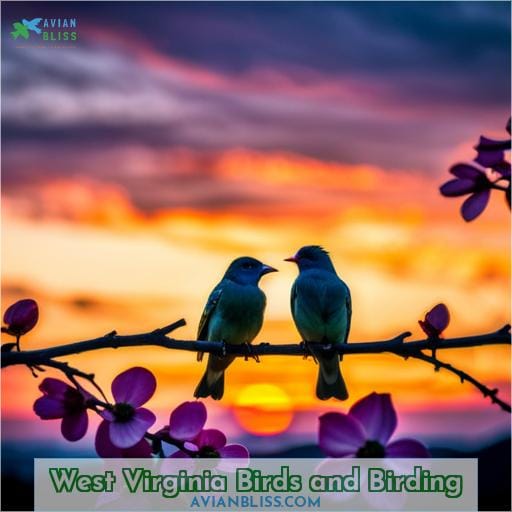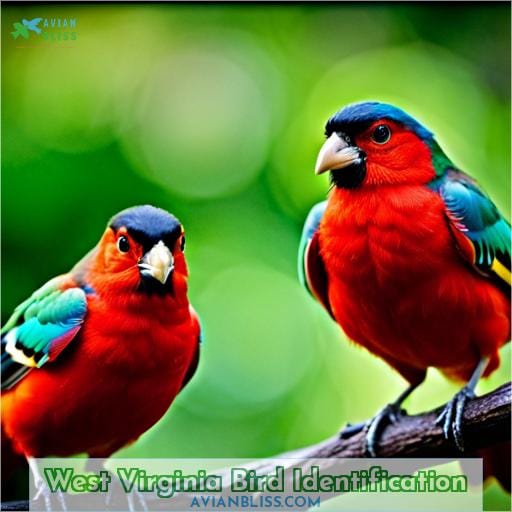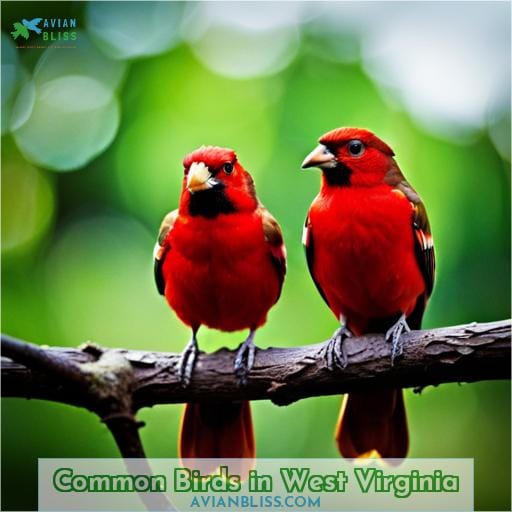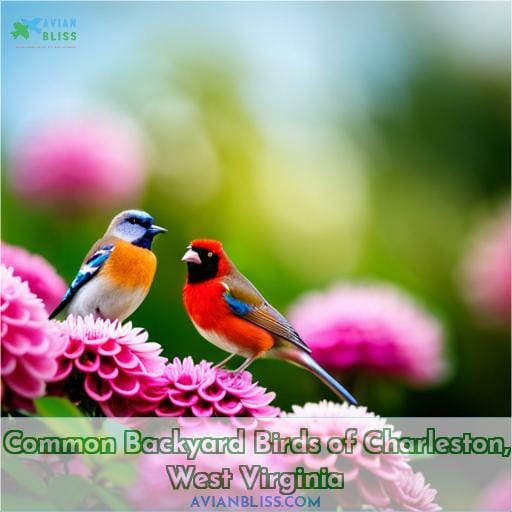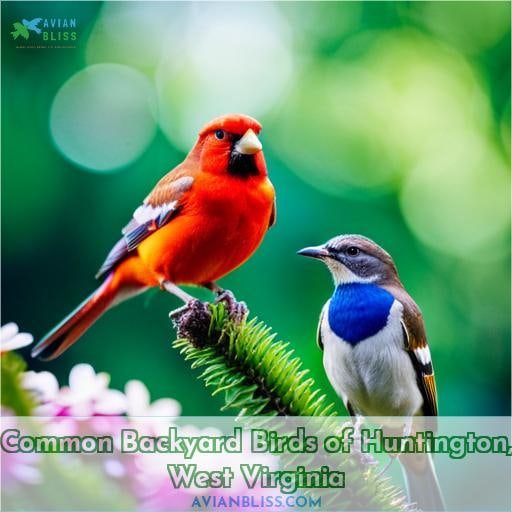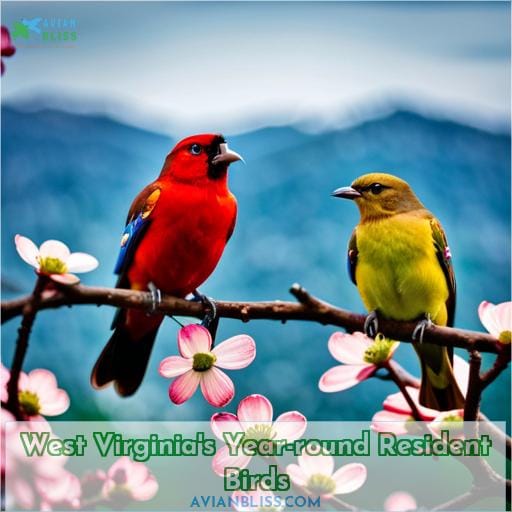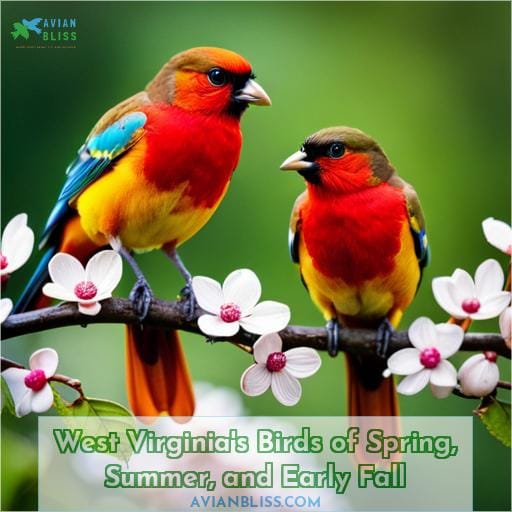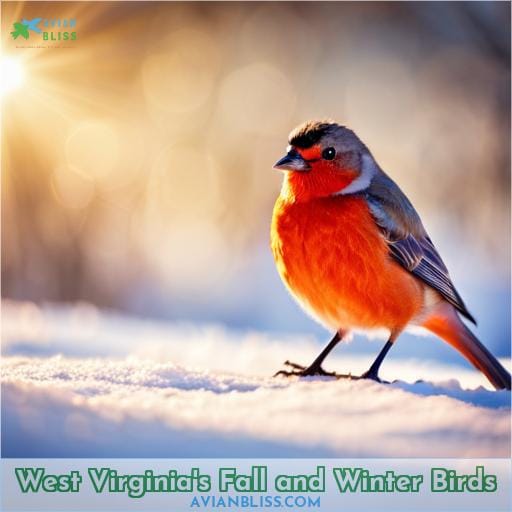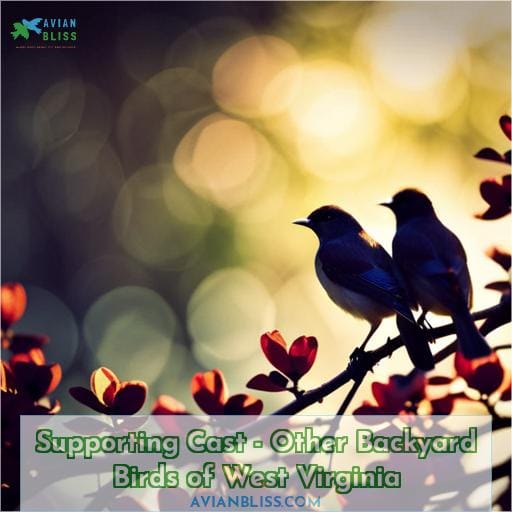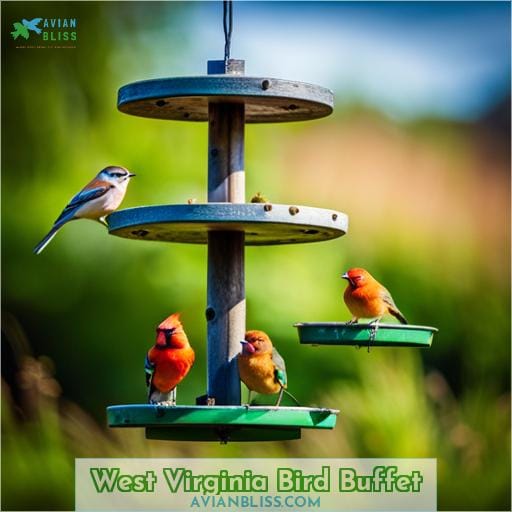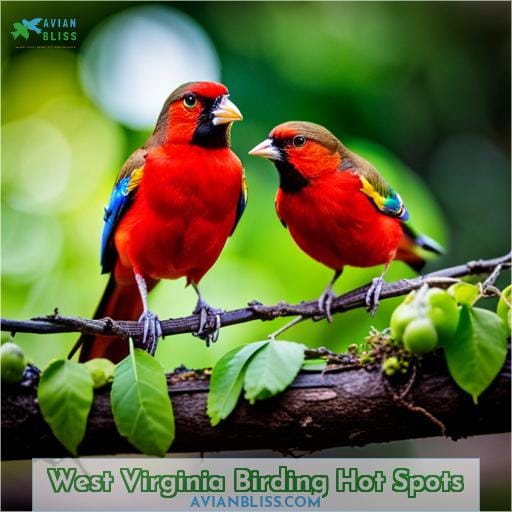This site is supported by our readers. We may earn a commission, at no cost to you, if you purchase through links.

From the majestic Northern Cardinal that graces your feeders to the clever American Crow, this guide unveils the diverse tapestry of species that call West Virginia home.
Intriguingly, the West Virginia Bird Records Committee boasts an impressive catalog of 352 species, a testament to the state’s rich biodiversity. As your knowledgeable companion, I’ll unveil the secrets of identification, behaviors, and seasonal patterns.
Imagine the thrill of spotting the Scarlet Tanager, a fleeting glimpse of summer’s brilliance, or marveling at the Dark-eyed Junco‘s resilience in the midst of winter. Through these insights, you’ll uncover the shared rhythm between your backyard and these feathered friends, fostering a sense of belonging and unlocking the gateway to a world brimming with freedom and wonder.
Table Of Contents
- Key Takeaways
- West Virginia Birds and Birding
- West Virginia Bird Identification
- Common Birds in West Virginia
- Common Backyard Birds of Charleston, West Virginia
- Common Backyard Birds of Huntington, West Virginia
- Common Backyard Birds of Morgantown, West Virginia
- West Virginia’s Year-round Resident Birds
- West Virginia’s Birds of Spring, Summer, and Early Fall
- West Virginia’s Fall and Winter Birds
- Supporting Cast – Other Backyard Birds of West Virginia
- West Virginia Bird Buffet
- West Virginia Birding Hot Spots
- Some Last Words
- Frequently Asked Questions (FAQs)
- How can I attract cedar waxwings to my backyard in West Virginia?
- Are there any specific bird species in West Virginia that are known for their unique mimicry abilities?
- What are some effective strategies for deterring common grackles from dominating my bird feeders in West Virginia?
- Are there any uncommon or rare bird species that have been spotted in West Virginia during the migration seasons?
- Can you provide tips on creating a bird-friendly garden in West Virginia that would cater to a variety of bird species throughout the year?
- Conclusion
Key Takeaways
- Diverse avian inhabitants in West Virginia’s backyard.
- Seasonal patterns and behaviors of different bird species.
- Creating bird-friendly spaces and gardens.
- Birding opportunities and events for enthusiasts.
West Virginia Birds and Birding
Explore the diverse landscapes of this beautiful state, where melodies from vibrant feathers fill the air, inviting you to immerse yourself in the captivating world of winged wonders. West Virginia’s rich tapestry of habitats, from woodlands to gardens, provides a haven for a stunning array of common backyard birds.
Engage your senses as you observe the Northern Cardinal’s playful presence atop wires, the American Crow’s striking black and white plumage in mature forests, or the Blue Jay’s raucous calls resonating in woodland edges, a hallmark of their complex social systems.
Capture these moments through birding photography tips that reveal the intricate beauty of each species. While delighting in the familiar company of American Robins and Song Sparrows, discover the thrill of attracting rare species to your backyard oasis.
Engage in seasonal birding events that unveil the spectacle of migration, infusing your experience with a sense of belonging to a grand natural narrative.
Witness the dedication of West Virginians towards bird conservation efforts, preserving habitats to ensure the freedom of these enchanting creatures. As you explore the state’s top birding hotspots, you’ll grasp a profound understanding of bird behavior and feeding habits.
In every corner of this landscape, a world of avian wonders awaits, inviting you to connect with the wild soul of West Virginia.
West Virginia Bird Identification
Delve into the captivating realm of West Virginia’s backyard birds with a focus on iconic species such as the Northern Cardinal, American Crow, Blue Jay, American Robin, and Song Sparrow. These distinctive avian residents grace the state’s woodlands, edges, and gardens, showcasing a vibrant spectrum of colors and melodies.
Northern Cardinal
Imagine yourself surrounded by the vibrant colors of the wild, where a striking creature, with its rich scarlet crown, perches gracefully on a swaying branch – a symbol of the North, its melodious song echoing through the air.
The Northern Cardinal, a prominent backyard bird of West Virginia, exhibits captivating behavior that draws bird enthusiasts. To attract these beauties, place bird feeders with sunflower seeds, tube feeders, and thistle socks.
Originally from deserts, their range has expanded to rural areas and towns, exemplifying nature’s adaptability. Cardinals prefer treetops and bushes, where they feed on various seeds. Their range expansion offers you the chance to witness their vibrant presence in your own backyard, adding a touch of freedom and belonging to your birding experience.
American Crow
Discover the intriguing allure of the American Crow as it graces your surroundings with its distinctive black and white markings, showcasing its powerful strikes on trees while foraging for carpenter ants.
Delve into their world with these insights:
Crow Behavior: These intelligent birds exhibit remarkable problem-solving skills, using tools to extract food from various sources and showcasing their adaptability.
Crow Habitat: Thriving in dense mature forests and coniferous landscapes, they navigate tree canopies with ease, displaying their mastery of aerial spaces.
Crow Diet: Carpenter ants, sunflowers, and peanuts constitute their diet, demonstrating their omnivorous nature and scavenging abilities.
Crow Intelligence: Known for their ability to remember human faces and recognize dangerous situations, crows possess an advanced level of cognitive intelligence.
Crow Vocalizations: From their iconic caw to an array of complex calls, crows communicate with a nuanced vocal repertoire, reflecting their social and cooperative behaviors.
Blue Jay
Amidst the woodland edges and forests, the stocky blue and white plumage of the Blue Jay contrasts sharply with the surrounding greenery, while its calls echo through the air.
| Behavior | Vocalizations |
|---|---|
| Intelligent and bold | Loud calls, mimicry |
| Caches food | Wide range of sounds |
| Nesting Habits | Feeding Preferences |
Cup-shaped nests
Well-hidden nests
Migrations
Partial migrations
Altitudinal movement
These traits connect you to the lively world of Blue Jays. They cache food to thrive during tough times, and their mimicry makes you feel like a part of their vibrant conversation.
Witness their stunning blue and white in West Virginia’s diverse landscapes.
American Robin
Embrace the enchanting melodies of the American Robin, as its vibrant rust-colored plumage contrasts beautifully against the woodland backdrop, evoking a sense of nature’s harmony.
American Robin Behavior: These summer residents of West Virginia are known for their delightful, melodious songs that resonate through the forested landscapes. Their calls symbolize the essence of the changing seasons.
West Virginia Robin Population: The American Robin is one of the most familiar and abundant backyard birds in West Virginia. Its cheerful presence adds a touch of vibrancy to gardens and woodlands alike.
Robin Diet Variability: Adaptability is a hallmark of their behavior. From spring to summer, their diet shifts from insects to berries, showing how these birds skillfully exploit available food sources.
Robin Nesting Habits: Observing their nesting habits is a captivating experience. These adept builders craft cup-shaped nests, often on ledges, porches, and other convenient locations, signifying their affinity for human habitats.
Song Sparrow
Explore the woodlands and edges of your surroundings, where the grayish Song Sparrow can often be found. Its melodious song fills the air, revealing its nesting habits and year-round presence as charming West Virginia backyard birds.
Common Birds in West Virginia
Exploring the avian inhabitants of West Virginia’s backyards reveals a captivating seasonal rhythm. Throughout the year, you’ll encounter a lively ensemble of common backyard birds, with each season bringing its own unique cast.
Winter graces your feeders with the stalwarts like Northern Cardinals, American Crows, and Blue Jays, while summer’s stage welcomes migratory guests, adding the vibrant chorus of Cedar Waxwings, Barn Swallows, and Wood Thrushes to the ensemble.
Most Common Backyard Birds Throughout the Year
Get ready to witness a spectacular avian extravaganza, where the skies come alive with a symphony of vibrant plumage and melodious calls throughout the year! Migration patterns bring red-winged blackbirds and eastern bluebirds in spring, while house sparrows and tufted titmice grace your backyard in winter.
Listen to the cheerful trills and observe nesting behaviors as the northern flicker showcases its seasonal plumage changes.
Most Common Backyard Birds in Winter
To truly appreciate the beauty of winter avian visitors, focus on the most frequent feathered guests during this season. Feeding Cardinals offer a vibrant contrast against the snowy backdrop. Snowy Sparrows and Frosty Blue Jays add charm to frosty landscapes.
Seasonal Avian Visitors like the common grackle, white-throated sparrow, dark-eyed junco, and American goldfinch grace your winter scene, enhancing your sense of belonging and freedom.
Most Common Backyard Birds in Summer
Discover a vibrant array of avian species gracing the lush landscapes during the warmer months, creating a symphony of colors and melodies that enrich your outdoor experience. Attracting Orioles adds a splash of brilliance to your garden, while Summer Warblers flit among branches in search of insects.
Create Hummingbird Gardens to witness these tiny marvels up close. Avian Watering Holes become bustling hubs, and the Evening Bird Chorus serenades the setting sun. Mourning doves, house finches, eastern towhees, chipping sparrows, and cedar waxwings contribute to the lively ensemble.
Common Backyard Birds of Charleston, West Virginia
Transitioning from the exploration of common birds in West Virginia, let’s now delve into the captivating world of the avian residents specific to Charleston.
In this vibrant city, you’ll find a tapestry of urban wildlife interwoven with the local landscapes. The backyards of Charleston come alive with the enchanting melodies of the red-bellied woodpecker, the cheerful calls of the white-breasted nuthatch, and the energetic chirps of the Carolina chickadee.
Amidst the bustling streets and charming neighborhoods, the northern cardinal reigns as a majestic sentinel, adding a splash of vibrant red to the Charleston scenery. As you venture through these urban landscapes, keep your ears attuned to the melodious trills of the eastern bluebird, evoking a sense of freedom and belonging in their sweet notes.
To further deepen your connection with these feathered neighbors, understanding their feeding habits becomes crucial. Observing the red-bellied woodpecker’s rhythmic drumming on tree trunks, or the white-breasted nuthatch’s acrobatic foraging, adds an element of intrigue.
The Carolina chickadee’s playful antics as it flits from branch to branch will undoubtedly bring a smile to your face. And as the sun sets on Charleston, the northern cardinal’s twilight serenade transforms the evening air into a symphony of avian sounds, a reminder of the beauty that surrounds us even in the heart of the city.
Common Backyard Birds of Huntington, West Virginia
Explore Huntington’s diverse landscapes to encounter a captivating array of feathered friends, inviting you to immerse yourself in the enchanting world of avian wonders. Huntington’s vibrant urban setting provides unique opportunities for birdwatching.
To catch a glimpse of the elusive red-eyed vireo and the graceful chimney swift, try your hand at nocturnal birdwatching. Listen to their melodic calls and observe their nighttime behaviors, granting you a deeper understanding of their lives.
For a splash of color, the eastern phoebe and the gray catbird grace the city with their presence. To create a haven for these charming species, consider cultivating a bird-friendly garden. Select native plants, such as berry-bearing shrubs, to entice them. Furthermore, barn swallows, known for their elegant aerial displays, can be spotted near water sources.
Incorporate birding techniques while exploring Huntington’s parks and trails, enabling you to spot various species. By attracting orioles with nectar feeders, you can witness their vibrant beauty up close.
Huntington’s avian residents offer a sense of belonging and freedom as you observe their natural behaviors amidst the city’s rhythm.
Common Backyard Birds of Morgantown, West Virginia
Get ready to immerse yourself in the vibrant avian life of Morgantown, where the lush landscapes come alive with a symphony of colorful feathers and melodic calls. Morgantown’s avian diversity creates a haven for bird enthusiasts, offering a true sense of belonging to nature’s tapestry.
Attracting Bluebirds: Transform your backyard into a haven for these stunning creatures with well-placed nest boxes. Witness their iridescent blue plumage up close, fostering a sense of connection to the sky.
Birdsong Mornings: Wake up to the soul-stirring melodies of Eastern Wood-Pewees and Red-Breasted Nuthatches, a morning ritual that invokes a sense of understanding and harmony.
Urban Raptor Sightings: Catch a glimpse of majestic urban raptors like the Red-Tailed Hawk soaring above the cityscape, igniting feelings of freedom and awe.
As you cultivate your own haven for feathered garden visitors, anticipate the thrilling sight of the resplendent Red-Headed Woodpecker and the diligent Downy Woodpecker. And if luck smiles upon you, the colossal Pileated Woodpecker might grace your surroundings, reminding you of the grandeur of the natural world.
West Virginia’s Year-round Resident Birds
Exploring the year-round residents among West Virginia’s backyard birds reveals the captivating behaviors of the Mourning Dove, European Starling, Downy Woodpecker, and Eastern Towhee. Observing Mourning Doves’ soft cooing and graceful foraging, you’ll be intrigued by their seed-based diet and adaptability to diverse habitats.
The European Starling’s iridescent plumage and dynamic vocalizations offer a fascinating study in avian communication, while the Downy Woodpecker’s rhythmic drumming and insect-seeking antics provide insights into its role within woodland ecosystems.
Lastly, the Eastern Towhee’s distinctive calls and distinctive scratching for insects on the forest floor unveil its intricate relationship with its environment.
Mourning Dove
Amidst the diverse landscapes, the gentle cooing of the Mourning Dove resonates, a soothing sound that often graces woodland edges and gardens, harmonizing with the melodies of other vibrant residents.
This dove’s behavior is characterized by its mournful cooing, a haunting yet comforting call that lingers in the air. Its feeding habits primarily revolve around seeds and grains, making it a frequent visitor to feeders.
Nesting patterns of the Mourning Dove reveal its adaptable nature, often choosing sites like trees, shrubs, or even human structures. As a year-round resident, its presence remains steadfast, with population trends indicating stability.
In the summer, the dove’s soft, grayish-brown plumage blends well with the natural surroundings. Its identification relies on the distinctive teardrop shape on its face and subtle hints of blue on its wings.
In the realm of feeder birds, the Mourning Dove holds a serene yet significant place, enriching the avian tapestry of West Virginia’s backyard.
European Starling
Discover the European Starling, a striking addition to West Virginia’s avian tapestry. With unique markings and vocalizations, it adapts seamlessly to diverse habitats, including urban settings. Despite its captivating behavior and vocal prowess, its invasive impact necessitates population control.
Downy Woodpecker
Navigate through the wooded landscapes, where a rhythmic tap resonates as the Downy Woodpecker diligently uncovers insects hidden within the tree’s sturdy bark.
Plumage Details:
- Black and white pattern on a small, sparrow-sized frame.
- Distinctive white markings down the wings.
- Males have a small red patch on the back of their heads.
Feeding Habits:
- Forages for insects and larvae beneath bark crevices.
- Also enjoys seeds and berries, often visiting suet feeders.
- Agile climbers, adeptly maneuvering tree trunks and branches.
Habitat Preferences:
- Thrives in various environments, from woodlands to gardens.
- Frequently spotted in parks and suburban areas.
- Prefers deciduous trees and shrubs for nesting sites.
Nesting Habits:
- Constructs small cavities in dead or decaying wood.
- Uses the same nesting sites year after year.
- Eggs are white and glossy, typically laid in clusters.
Observing the Downy Woodpecker during bird watching sessions provides a glimpse into West Virginia’s backyard diversity. These charming residents, alongside the red-bellied woodpecker, contribute to the state’s vibrant avian tapestry.
Eastern Towhee
Explore the state’s diverse avian residents further with the Eastern Towhee. Recognizable by its distinctive call, this bird contributes to nearly 7% of West Virginia’s year-round bird soundscape. The Eastern Towhee inhabits brushy areas, thickets, and woodland edges. It forages on the ground, scratching for insects, seeds, and berries.
Its song pattern varies widely, with a distinctive drink your tea call. While some individuals might migrate during the winter, many stay, adding a touch of nature’s beauty to the cold months. The breeding season witnesses males singing to attract mates and establish territory.
Share your space with this avian neighbor and enhance the tapestry of your backyard bird community.
West Virginia’s Birds of Spring, Summer, and Early Fall
Delve into the vibrant world of West Virginia’s spring, summer, and early fall avian residents. Among the tapestry of feathered inhabitants, you’ll encounter the Scarlet Tanager’s striking red and black plumage, the brilliant blue of the Indigo Bunting, the intricate patterns of the Cape May Warbler, the melodious notes of the Summer Tanager, and the elusive allure of the Hooded Warbler amidst the lush landscapes.
Scarlet Tanager
Immerse yourself in the vibrant tapestry of colors as the Scarlet Tanager graces the woodland edges, its vivid plumage contrasting against the lush green foliage.
Scarlet Tanagers are known for their striking plumage shifts between seasons. During spring and summer, males boast brilliant scarlet feathers that make them a sight to behold.
Their song patterns are equally enchanting. Listen for their distinctive and melodious chip-burr calls echoing through the forest. To attract Scarlet Tanagers to your backyard, consider providing a mix of insects, particularly caterpillars, and ripe fruits in your bird feeders.
These offerings mimic their natural diet, making your yard an attractive destination.
Scarlet Tanagers are neotropical migrants, traveling from their wintering grounds in South America to breed in the lush woodlands of West Virginia during spring and early summer. This remarkable migration is a testament to their strong desire for freedom and survival.
Understanding their breeding habits is essential. They nest in the canopies of deciduous forests, carefully concealing their nests among leaves and branches. Witnessing the nesting behaviors of these backyard birds can be a truly rewarding experience for bird enthusiasts.
In West Virginia, Scarlet Tanagers are an integral part of the diverse bird groups that grace the state’s landscape. Their arrival heralds the arrival of warmer seasons, adding to the sense of belonging for birdwatchers who appreciate the beauty and wonder of the natural world.
So, prepare your feeders, listen for their songs, and marvel at the Scarlet Tanager’s remarkable journey and contribution to the state’s backyard bird diversity.
Indigo Bunting
In the realm of this colorful tapestry of song and wing, within the heart of spring’s symphony, behold the radiant Indigo Bunting, a bewitching brushstroke of azure amid nature’s canvas. With vibrant plumage that defies the sky’s blueness, this backyard beauty is a symbol of freedom.
Its attraction is undeniable, drawn to diverse habitats where woodlands meet meadows, and where its melody blends with the rustling leaves. In West Virginia’s warm embrace, witness the Indigo Bunting’s seasonal transformation as it graces the landscape with its celestial hues and ethereal song.
Cape May Warbler
Discover the Cape May Warbler, a springtime birding delight in West Virginia. With vibrant yellow plumage, this colorful migratory visitor stands out. Watch its unique feeding preferences and listen to its distinctive song, adding to the state’s diverse bird species.
Summer Tanager
Follow the melodious tunes of the Summer Tanager as its vibrant red plumage flits among the trees, adding a splash of color to the lush woodland edges and inviting you to experience the serenade of the warm season.
Song Repertoire: The Summer Tanager’s repertoire echoes through the foliage, a blend of clear phrases that resonate with the freedom of summer days.
Habitat Preferences: Seek the tanager’s scarlet hues in deciduous forests, where it seeks refuge among the leaves, a fleeting gem against the green backdrop.
Breeding Behavior: Watch for the tanager’s courtship dances and nesting rituals, a timeless spectacle that highlights the primal desire for belonging and continuity.
Interaction with Other Species: Marvel at the interactions as the tanager’s vibrant plumage catches the eye of the ruby-throated hummingbird, contrasting with the hues of the wood thrush, hooded warbler, and yellow-bellied sapsucker.
Feel the embrace of nature’s symphony, a tapestry woven with melodies, colors, and relationships that resonate with your yearning for understanding and connection.
Hooded Warbler
Sure thing! Picture this: a vibrant, feathered performer takes center stage amidst the lush foliage, belting out a melodious tune that could put even the most seasoned crooner to shame – a true woodland rockstar, if you will.
| Behavior | Nesting Habits | Migration Patterns |
|---|---|---|
| Energetic forager | Low, shrubby vegetation | Neotropical migrant |
| Sings from canopy | Ground-nesting | Summers in West VA |
| Agile insectivore | Cup-shaped nests | Winter in tropics |
The Hooded Warbler, a petite marvel, boasts energetic foraging behavior. It flits through low, shrubby vegetation, its melodious song resonating from the canopy. This neotropical migrant graces West Virginia in summer, nesting on the ground within cup-shaped nests.
Enjoy its vibrant presence alongside other woodland gems like the Yellow-rumped Warbler, whose yellow splash complements the Hooded Warbler’s attire. The Golden-crowned Kinglet, with its distinct head markings, and the White-crowned Sparrow, a study in elegant contrasts, complete this avian ensemble.
In the tapestry of West Virginia’s biodiversity, these birds symbolize belonging, understanding, and the freedom of nature’s symphony.
West Virginia’s Fall and Winter Birds
As you delve into the realm of West Virginia’s fall and winter birds, prepare to encounter a fascinating array of species that include the Dark-eyed Junco, Carolina Chickadee, Evening Grosbeak, and Purple Finch.
These resilient birds bring a unique charm to the colder months, each with distinctive behaviors and adaptations that make them a captivating subject of observation during the chillier seasons.
Dark-eyed Junco
Explore the fascinating world of the Dark-eyed Junco, a charming little bird that graces the region during the colder months.
Behavior and Habitat: Dark-eyed Juncos, commonly known as snowbirds, are ground-dwelling sparrows. They forage in groups, hopping and scratching for seeds beneath shrubs and feeders. These birds have an innate sense of hierarchy within their flocks.
Feeding Habits: Juncos primarily feed on seeds, making them frequent visitors to backyard feeders during winter. They favor millet, sunflower seeds, and cracked corn. Observing their feeding dynamics can offer insights into their social structure.
Plumage Variation and Migration: The Dark-eyed Junco showcases distinct plumage variations, with slate-colored and Oregon forms being common in West Virginia. As winter arrives, juncos migrate southward, and the arrival of these winter guests adds diversity to the backyard birdwatching scene in Huntington, Morgantown, Kanawha County, Cabell County, and beyond.
Carolina Chickadee
Dive into the realm of feathered companions by meeting the Carolina Chickadee, a petite yet spirited avian character that adds its melodious notes to the symphony of nature’s performers.
This tiny bird is known for its energetic behavior and distinctive vocalization, often heard singing chick-a-dee-dee or fee-bee. The Carolina Chickadee prefers woodland habitats with dense vegetation and trees where it builds nests in tree cavities or nest boxes.
As one of West Virginia’s year-round resident birds, this charming species contributes to the vibrant birdlife in the Mountain State alongside other avian residents like purple finches and evening grosbeaks.
| Carolina Chickadees | |||
|---|---|---|---|
| Behavior: Energetic; Distinctive vocalizations (Chick-a-dee-dee) | |||
| Habitat Preferences: Woodlands with dense vegetation; Trees for nesting | |||
| Nesting Habits: Builds nests in tree cavities or nest boxes | |||
| Feeding Habits: Insects | Seeds | Berries | Suet Feeders |
In conclusion,
The Carolina Chickadees are captivating creatures that bring joy through their lively antics and beautiful melodies. Whether you’re an avid birder or simply enjoy observing nature from your backyard feeder, these small but mighty songsters make any outdoor experience feel complete! Embrace their presence as they harmonize with other feathered friends throughout West Virginia’s forests, adding a touch of enchantment to our beloved mountain state.
Evening Grosbeak
Discover the Evening Grosbeak, a striking addition to your local avian scene. Vibrant plumage and distinctive calls add a new dimension to outdoor encounters. Nocturnal behavior, habitat preferences, and feeding habits contribute to their enigmatic allure.
Their range expansion, including Monongalia County, enriches the birdwatching experience.
Purple Finch
Observe the vibrant Purple Finch with its reddish plumage and distinctive streaks, adding a splash of color to woodland edges and gardens. This finch, known for its melodious song, is a delightful visitor. Attract them with sunflower and thistle seeds.
They exhibit plumage variations, and their bill type is adapted for seed-cracking. During migration, they bring a dynamic presence alongside other species like pine siskins and brown creepers.
Supporting Cast – Other Backyard Birds of West Virginia
Delve into the captivating world of West Virginia’s backyard birds, where the American Goldfinch, Tufted Titmouse, Eastern Bluebird, Red-bellied Woodpecker, and White-breasted Nuthatch take center stage.
These avian inhabitants offer an intriguing array of behaviors and characteristics that make them stand out amidst the natural tapestry, inviting you to observe their vibrant plumage, unique foraging techniques, and enchanting melodies as they thrive within the state’s diverse landscapes.
American Goldfinch
As you explore the vibrant landscapes of this region, you’ll often come across the sociable American Goldfinch, with its bright yellow plumage adding a touch of sunshine to the natural tapestry around you.
Attracting Goldfinches is a delightful endeavor, as they’re particularly drawn to gardens adorned with native plants that provide ample seeds. Their seasonal behavior is fascinating, as they undergo a molt in late summer, transforming from their vibrant yellow summer attire to a more subdued olive shade for winter camouflage.
These charming birds have specific feeding preferences, relishing in the consumption of thistle seeds and sunflower hearts. Goldfinches are quite adaptable and can be found in a variety of habitats, including gardens, meadows, and open woodlands.
When it comes to breeding patterns, they typically wait until late June or early July to nest, choosing locations that offer ample cover, such as shrubs and trees.
Enjoy the freedom of observing these dynamic creatures in your backyard haven.
Tufted Titmouse
Take a moment to picture a small, blue-gray bird with a distinctive crest perched among coniferous trees. Its active and curious nature adds liveliness to the wooded landscape. Titmice explore woodlands, forage for insects, and interact around feeders, showcasing their charming crested antics.
Eastern Bluebird
With the flutter of azure wings, the Eastern Bluebird brings a slice of the cerulean sky into your world, serenading your surroundings with melodious notes. Their charming behavior includes graceful swoops and perching to spot insects. To attract Bluebirds, provide nest boxes with proper dimensions and entrance holes.
They exhibit fascinating nesting habits, often using pine needles, grass, and feathers to craft their nests in tree cavities. Conservation efforts focus on preserving open spaces and erecting nest boxes. These captivating creatures prefer mealworms and fruit, making a diverse feeder essential for their well-being.
Red-bellied Woodpecker
Explore the vibrant allure of the Red-bellied Woodpecker as it showcases its distinctive black and white markings among the woodland tapestry. This woodpecker is a skilled forager, probing tree bark for insects. Its habitat preferences include wooded areas and suburban gardens.
To attract this striking bird, offer suet feeders and provide nesting opportunities. The Red-bellied Woodpecker’s plumage boasts a zebra-like pattern on its back, and its reddish cap adds a touch of warmth to the scene.
Witnessing its agile maneuvers and resonating calls, you’ll feel a sense of belonging to the natural world.
White-breasted Nuthatch
Discover the lively and energetic presence of the White-breasted Nuthatch in your surroundings, enjoying its distinctive appearance and frequent visits to feeders. This nuthatch’s behavior is a delight to observe – it often creeps headfirst down tree trunks, showcasing its agile movements.
Feeding preferences of the White-breasted Nuthatch include a fondness for insects, seeds, and nuts, making it a versatile diner at your bird feeding station. Its habitat preference leans towards deciduous and mixed woodlands, where it uses its strong bill to extract food from crevices in bark.
Vocalizations of nuthatches add to the symphony of your backyard soundscape. Their distinct yank-yank calls are easily recognizable and contribute to the sense of belonging in nature. Nuthatches are known to nest in tree cavities, demonstrating their adaptability to varying nesting sites.
Witness the freedom of the White-breasted Nuthatch as it navigates your backyard with its acrobatic foraging and charming vocalizations. Embrace the understanding that these birds bring to your outdoor space, creating a harmonious connection with the natural world.
West Virginia Bird Buffet
Transitioning from the diverse cast of backyard birds in West Virginia, let’s delve into a fascinating aspect of avian interaction – their feeding preferences. Attracting a vibrant array of species to your backyard requires a thoughtful approach.
Different birds have distinct culinary inclinations. Cardinals and finches delight in sunflower seeds, while woodpeckers relish suet. Blue jays and crows, omnivorous by nature, appreciate a medley of grains, insects, and nuts.
To cater to these preferences, crafting DIY feeders can be a fulfilling project. Consider crafting a platform feeder for ground-feeding species or a tube feeder for finches.
Placement matters just as much as food. Hang feeders in the vicinity of trees or shrubs for cover, allowing birds to observe before approaching. Having an ample distance from windows minimizes bird collisions. Align these practices with the changing seasons; offer fruit in spring for migrants and high-energy foods in winter.
Through this endeavor, your backyard transforms into a haven, a stage where birds harmonize and thrive, aligning your desire for understanding and belonging with their natural freedom.
West Virginia Birding Hot Spots
Intriguingly, you’ll find that there are over 180 species of these feathered residents waiting to greet you in the various captivating birding locales across the state.
West Virginia’s birding trails and wildlife sanctuaries are a haven for bird enthusiasts, offering a symphony of bird songs and a canvas of breathtaking landscapes.
As you traverse these trails, equipped with your trusty birding binoculars and camera, the changing seasons usher in a dynamic cast of avian characters.
Spring and fall bring a mesmerizing migration spectacle, with colorful warblers and other transitory species making a pit stop in these welcoming havens.
From the tranquil woodlands to the inviting gardens, each setting provides a glimpse into the lives of these charming creatures.
Capture the vibrant moments of fluttering wings and delightful calls through your bird photography, preserving the memories of your encounters.
West Virginia’s birding hot spots offer not only a chance to witness nature’s marvels but also an avenue for connecting with a shared passion.
Amidst these landscapes, you’ll find a sense of belonging, a deeper understanding of avian behaviors, and the freedom to explore the beauty of the state’s biodiversity.
So, embark on your birding journey and immerse yourself in the symphony of nature’s finest performers.
Some Last Words
Explore the variety of species that thrive in this region and savor the joy of birdwatching among the captivating landscapes. Avian Adventures await as you delve into the realm of West Virginia’s backyard birds. From the charming melodies of the Song Sparrow to the energetic calls of the Carolina Wren, each encounter paints a vivid picture of nature’s symphony.
Delight in the Seasonal Delights as migrants grace your surroundings during spring and fall. Witness the vibrant transformation of the American Goldfinch, adorned in sunny yellow during summer and muted olive in winter.
As you observe these feathered wonders, consider the Conservation Concerns that face some of these species. Take part in preserving their habitats and ensuring their survival for generations to come.
Your journey is bound to bring Unexpected Sightings, as nature always has surprises in store. Amidst the lush woodlands and garden retreats, the beauty of West Virginia’s birdlife unfolds.
So venture forth, armed with binoculars and curiosity, and embrace the sense of belonging and freedom that accompanies every step of your birdwatching odyssey.
Frequently Asked Questions (FAQs)
How can I attract cedar waxwings to my backyard in West Virginia?
To entice the elusive Cedar Waxwings to your West Virginia yard, provide a feast of berry-laden trees like dogwood, hawthorn, or serviceberry. These sleek creatures gather in flocks, bestowing your haven with an enchanting touch of nature’s elegance.
Are there any specific bird species in West Virginia that are known for their unique mimicry abilities?
Discover the enchanting mimicry of the Northern Mockingbird in West Virginia. With a vast repertoire, it weaves diverse calls into its song, resonating with the yearning for connection and the freedom of nature’s symphony.
What are some effective strategies for deterring common grackles from dominating my bird feeders in West Virginia?
Yearning to restore feeder balance, employ Mimicry Defense. Mimic distress calls of smaller birds to deter grackles. Feeding stations foster shared avian harmony—welcoming both local and transient beauties.
Are there any uncommon or rare bird species that have been spotted in West Virginia during the migration seasons?
Amidst West Virginia’s seasonal symphony of avian travelers, behold rare jewels: the striking Scarlet Tanager, resplendent Blackburnian Warbler, and elusive Golden-winged Warbler.
Can you provide tips on creating a bird-friendly garden in West Virginia that would cater to a variety of bird species throughout the year?
Create a thriving haven for West Virginia’s feathered inhabitants. Craft a mosaic of native plants, offering food and shelter year-round. In this dance of colors and life, your garden becomes a shared sanctuary, where diverse wings find solace.
Conclusion
As you traverse the enchanting landscapes of West Virginia, a symphony of avian melodies awaits your attentive ear and keen gaze. Embark on a captivating journey through the world of backyard birds in this picturesque state.
From the charismatic Northern Cardinal, bedecked in shades of brown and gray with a fiery crown, to the clever and adaptable American Crow, adorned with striking black and white plumage, each feathered inhabitant has its tale to tell.
As you meander through woodlands and gardens, the Blue Jay’s vibrant blue and white plumage may catch your eye, while the American Robin’s melodic song fills the air, evoking the essence of the forest.
The Song Sparrow, a grayish marvel with a round head and melodious trill, adds its own harmonious notes to the chorus.
In this avian tapestry, the year unfolds with a diverse cast of characters. The iconic Northern Cardinal, the resilient American Crow, and the charismatic Blue Jay remain steadfast throughout the seasons.
Winter sees the emergence of Dark-eyed Juncos and Carolina Chickadees, while spring and summer herald the arrival of Scarlet Tanagers and Indigo Buntings, painting the landscape with vivid hues. The enchanting Tufted Titmouse and the American Goldfinch join the avian ensemble, adding their own flair to the symphony.
As you delve into the world of West Virginia’s backyard birds, the richness of its biodiversity is truly remarkable. From the lush woodlands to the tranquil gardens, these feathered beings are both scientific marvels and poetic inspirations.
So, as you embark on your birdwatching adventure, remember that these backyard birds of West Virginia hold within their wings a world of wonder and discovery, waiting for you to explore.

